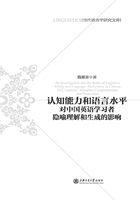
1.6 The organization of the book
This book contains six chapters.Chapter 1 is a general introduction, providing a rough picture of the current situation of metaphor research in applied linguistics as well as some relevant terms such as cognitive ability, language proficiency, metaphor comprehension and production.Chapter 2 focuses on the working definition of metaphor based on a comparative study of the classical and contemporary metaphor theories by Aristotle and Lakoff respectively, with a view to advancing a theoretical framework which can be effectively used in applied linguistics.Relationships among metaphor, cognition and language learning are also discussed in this chapter.Chapter 3 is the relatively detailed literature review of metaphor research and, more importantly, problems with it in foreign language(FL)and/or second language (SL)settings7.Chapter 4 is devoted to the experiment design in which issues such as subj ects, procedures, data collection, scoring are accounted for.Chapter 5 deals with the results and the preliminary discussions of the results.Included in the last chapter are the general discussions, conclusions, implications, limitations of the present research and the suggestions for the future research.
Notes
1.Relevant literature reveals that researchers interested in metaphor study often use different terms to refer to the language that is not literal.The frequently used ones are figurative language, metaphorical language, non-literal language, etc..As a matter of fact, these terms are often used interchangeably.Therefore, this convention also applies to this study for the convenience of expression.
2.The present author once carried out very informal interviews with most of his colleagues teaching English as a foreign language for Chinese college students, asking them what metaphor is.The result demonstrates that almost over ninety five percent of them responded very without any hesitation that metaphor is a figure of speech; it is rhetorical.When pressed further by questions such as whether they know how to make students master this kind of language phenomenon, many of them gave a negative answer nearly unanimously and acknowledged that they themselves were poorly equipped with this knowledge.
3.Kuhn is a world renown American scientist famous for his book The Structure of Scientific Revolutions, first published in 1960, and reprinted for several times.Its publication has stirred a great sensation and restless discussion in different academic circles, among which language teaching is one.Interested readers can refer to Yang Yonglin(1999:420-427)and Willis & Willis (2002:4-9)for detailed information.
4.In this book, language proficiency, linguistic ability, linguistic competence can be used interchangeably to refer to the same thing unless they are emphasized respectively.
5.The study of metacognition can be traced back to Plato and Aristotle when they discuss learners'thinking about their own thinking(Brown 1987).Although they do not ostensibly use metacognition as a formal term, it means almost the same as what the term currently conveys.Metacognition, a term for the concept of thinking about or controlling one's own thinking and learning processes, was not formally introduced until 1976 by Flavell.Flavell(1976:232)defines metacognition as“one's knowledge concerning one's own cognitive processes and products or anything related to them”.It also includes“the active monitoring and consequent regulation and orchestration of these processes in relation to the cognitive obj ects or data on which they bear, usually in the service of some concrete goal or obj ective”.
6.Graham(1997:42-43)argues, “The distinctions between cognitive and metacognitive strategies are important, partly because they give some indication of which strategies are the most crucial in determining the effectiveness of learning.It seems that metacognitive strategies, that allow students to plan, control, and evaluate their learning, have the most central role to play in this respect, rather than those that merely maximize interaction and input...Thus the ability to choose and evaluate one's strategies is of central importance.”As the definitions of metacognition and cognition suggest, the defining criterion to distinguish one from the other should be the function each performs in learning or cognitive processes.Accordingly, cognitive strategies are mainly used to help a learner to fulfill a particular cognitive obj ective while metacognitive strategies are used to ensure that the obj ective has been met.
7.Applied linguists use a variety of terms such as first language (L1), second language(L2 or SL), foreign language(FL)to differentiate languages acquired or learnt in different contexts. Detailed knowledge of the distinction between these terms can be found in Stern(1997).In the present research, in order to keep the term as consistent as far as possible, we prefer to use foreign language(FL)to refer to the language taught and learnt in a foreign environment, namely, learnt without much contact or communication with native speakers.In other words, it mainly refers to the language besides mother tongue learnt in formal classroom teaching.However, for the sake of convenience and authenticity, we have to follow different terms in description since the terms vary in different literature.